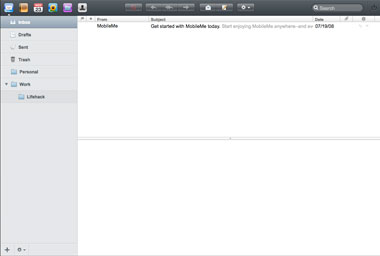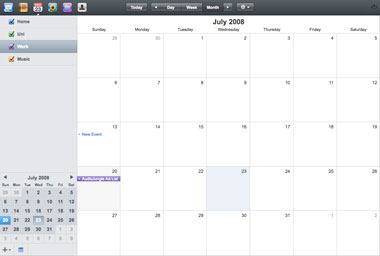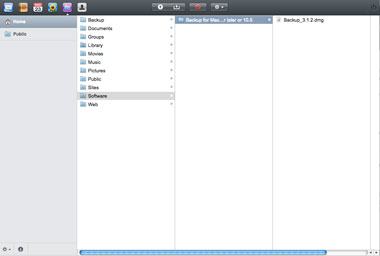It’s been a rocky start for Apple’s MobileMe, but things look like they’re settling down now and the service is, for the most part, chugging along. If you’re an optimist, the botched launch wasn’t such a bad thing after all, with Apple issuing free trial periods of up to four months before the subscription fee kicks in for affected users. I’ve been lucky—I haven’t had to put up with any of the teething problems since I signed up for my account a few days ago. Though I suppose you could call that unlucky, since it means I’ve only got a 60 day trial period. The main complaint about MobileMe has been that Apple billed it as a perfect push solution for all platforms, which turned out to be untrue and Apple quickly changed its tune. If you didn’t hear already, the original claim was that MobileMe would push to and from your Mac, PC, iPhone and the cloud. Unfortunately, Macs and PC can’t do push with MobileMe, whether it’s to push information out or to receive pushed data. This is really bad form, and seems to me like a case of Apple saying “if you don’t explicitly say anything, it’s not lying,” but they’ve since retracted their claims and despite my disappointment it’s not going to affect the outcome of this review.
Registration
Registration was quick and easy. Enter some personal details and billing information, and you’re done. Go to me.com and log in. Unfortunately for some, it wasn’t such a simple process when Apple charged the full service fee to credit and debit cards rather than just charging the $1 needed to verify the card. This issue has since (we hope!) been fixed.
The MobileMe Mail offering looks good. That’s probably the best thing I can say about it. At a basic level, it does the job. You can send and receive email, (manually) sort it into folders, flag messages, and contribute to the mass of people who send ten thousand forwards a day. It’s so advanced it has a forward feature, but that’s where the technological wonder really stops. Does it surprise anyone but me that a $99 offering that uses push technology, of all things, doesn’t even have a filtering system? It doesn’t even have the basic Rules functionality of Apple Mail on the desktop. This is ridiculous. It pretty much makes MobileMe’s mail component unusable for anyone interested in productivity. But the interface is well-designed. It’s intuitive and easy to use despite its utter minimalism, and everything is at most two or three clicks away. If there were filters and rules, I could see myself using this app. I’m a fan of the Quick Reply feature. If you don’t want a pop-up window with the full-featured composer you can click the Quick Reply button in the list view and have a simple overlay appear with a text box, and three options: Reply All, Cancel and Save. Very cool. Like many, I’m not too impressed with the lack of built-in Send As capability. Especially with 10 GB of storage, which trumps Gmail’s 6 GB, I want to have a central, consolidated email control center.
Contacts
I like Contacts. It’s much like Address Book on the Mac, and it’s pleasantly simple without sacrificing the functionality you need. Dustin asked me which system I use to manage contacts a few weeks ago. At the time I wasn’t happy with anything I’d tried, so I basically let my contacts rot in disorganization. Granted, this had never presented a problem, hence the continued disorganization, but now I’ve found a solution I’m enjoying that keeps my contacts synced across the board. That was the main problem before: how could I have my contacts synced on my Macs, on PCs and on my Windows Mobile phone? I don’t have a Win Mobile phone anymore—I was going to trade it in for an iPhone, but it must have seen it coming because the screen cracked suddenly and inexplicably. Regardless, you could still sync MobileMe contacts with Windows Mobile through Outlook and ActiveSync. Unlike Mail, Contacts has one feature that actually surpasses the desktop version’s equivalent: you can get an overlay Google Maps view of the address in any contact entry (as long as it has an address entered, of course). The closest you get in the desktop Address Book is a Google Map that opens up in your browser. No in-app overlays to be found. Push on the contacts between the iPhone and the cloud is flawless. That goes for Mail and Calendar too, I should add. I did some tests with various contact details, including grabbing a photo from MobileSafari, adding it as a contact’s display picture on the iPhone and then checking the cloud straight after. It was pretty damn instant. Of course, the big let down for push lovers is that it doesn’t work with the PC or Mac at this point, and contacts is the only app where I really would love complete, multi-directional push to occur. That said, the desktop synchronization had no problems.
Calendar
I don’t really use iCal a whole lot. I once did, for a task list I managed through Anxiety anyway. Now I use paper for my task list and I never enter appointments into a calendar, so this isn’t something that was a big deal for me either way, except for one thing I’ll talk about in a moment. My usage of the calendar may change now that I’ve got an iPhone, though. All that said, the MobileMe app is good—it’s probably the most similar of the three main apps compared to their desktop siblings. The way you enter events is the same as in iCal—dragging a selection on the calendar itself—though it could be a little smoother. The animation and creation of the event is slow and sluggish, at least for me. The killer is that I use iCal for one thing and one thing alone, and it’s not included in Calendar: calendar subscriptions. Everything else is almost identical. But if you want subscriptions you’ve got no options other than to export your subscription from iCal as a hard, static calendar. What’s the point? Of course, this also means you can’t share your calendar; no subscription option, and no web-based “sharing” option has been made available either. And in that vein, you can’t send email invitations. If you want any kind of collaborative calendar, stick to Google’s. If you just want to pile your own appointments in, you’ll be fine.
Gallery
Gallery is a nice photo storage and sharing option. It’s probably the least used of the apps for me, since I’m not much into photography nor into the idea of sharing those I do take. But for the purposes of product testing I did give it a workout. Using my iPhone and iPhoto, sending photos up to the cloud was easy and uncomplicated. It’s also a pretty simple matter to upload photos from the web interface, but I think the uploading aspect of this app is really built around your use of an iPhone or iPhoto and it’s much more pleasant to upload files that way. The URL for sharing an album or a photo with others is located in the dashboard or “dock” that occupies the top of the MobileMe suite. This is really a matter of copy, paste and send: showing your photos to others in a semi-private environment is easy. If you want a public and social photo-sharing environment, get to Flickr. I personally love this because I (personally) think Flickr is evil and privacy-shattering, and shouldn’t be used by anyone but actual photographers or people who take photos of themselves and nobody else. ;) This app certainly had fewer disappointing let-downs than the others.
iDisk
iDisk is nice and snappy on my Mac, and the web interface is not much different to the Finder interface. I can’t compare iDisk with MobileMe to the .Mac version because I never used it, but I think I’m going to start using it a lot in the months to come. The preset folder structure is pretty handy because a) it mirrors the folders commonly used on your Mac and b) if there wasn’t a preset folder structure I’m certain most people would just dump a mess of files in there and never clean them up. Perhaps they still do. Right-clicking a file allows you to rename it—that’s a nice touch, since renaming files through a web interface is usually a pain. Like the Gallery, iDisk offers some pretty good sharing features which include integration with Contacts.
Deal-breakers
- Lack of filtering – for the average reader of a blog like Lifehack, the lack of filtering capability is going to be a total deal-breaker. It’s incredibly irritating not to have this most basic of capabilities in a US$99 package, when that capability can be found in pretty much every single free mail account on the web.
- International prices – what has annoyed me and many Australians is that this product is being sold to Aussies well above the exchange rate. There’s practically no difference between our currencies and we’re expected to pay $20 more. I’m sure many of you in countries other than the US can sympathize. I know it’s a not a huge amount of money (for most people, anyway), but it’s a matter of principle. Hey, guess what Apple? There is a world outside of America. And since MobileMe is a solely digital offering there’s really no excuse. Not that there’s any way to excuse a $700 premium like the one on the MacBook Air. If you’re someone who makes decisions based on principle, this may be enough to turn you off. But enough ranting—back to MobileMe.
- It’s not a “digital control center” – for a $99 package that bills itself as your life on the cloud, with apps for mail, contacts and calendar, I think the mail offering needs to be much more flexible (I’m talking way beyond mere filters) and it needs to offer plenty more options for information consolidation. I love Gmail because I can run every single one of my email accounts from one webmail interface without appearing liek I use one free email address. There are cases where it’s totally inappropriate and unprofessional to use an address like jfalconer@me.com (not the real address, so don’t bother trying it), and MobileMe offers no alternative. I can’t consolidate accounts and send-as with them as smoothly as I can with Gmail.
- Calendar can’t do subscriptions – the only way I ever remember anyone’s birthday is thanks to my iCal subscription. It’s tough to admit, but true. Geni.com, which I reviewed many months ago, would do the trick if it didn’t happen to tell me the day after because of time zone problems. So I depend on an iCal subscription that generates a calendar from the birthdays I’ve listed in my Address Book contacts. I could always take the route of not giving a damn, but I’m not sure my son would be too happy with the sudden lack of wallet-emptying birthday gifts. If the product were free, none of these would really be deal breakers because there’d be no risk in using the service. You could use the calendar and contact syncing and nothing else, and still be happy with the purchase. But the mail, while very aesthetically pleasing, is totally useless without even basic filtering and built-in Send As features.
Best Outcomes for Productivity
I wish I could say that somehow, having push functionality is productivity-enhancing. But really, it’s just something cool to show geeky friends, who won’t care because it’s old tech anyway, and it’s a minor convenience. Push isn’t a magic bullet, and chances are it’ll actually decrease your productivity in the case of email. There’s nothing productivity-detracting about calendar or contact push, but if your main email account is interrupting you every single time you get a message, odds are you’ll never get work done. At the end of the day, the optimal outcome is the convenience of not having to worry about how up-to-date your iPhone’s contacts are. I have to say the best thing productivity-wise that came out of setting up MobileMe is that it forced me to clean up and organize my contacts. Well, it was also because for the first time ever I have a phone that synchronizes with Address Book.
Verdict
If having smooth sync between all your computers for calendar and contact data is important to you, then MobileMe may be worth the money. Also, if having a push email account sounds like a good idea even without filtering, then go for it. Especially if you don’t have access to an Exchange server (like most of us), and don’t even suggest Yahoo! Mail. That’s not real email. ;) I can see how this very limited email account’s push capabilities could be useful for me—give the address to a select few people who I can trust to follow “the rules” about email usage so they can contact me when something really does need my immediate attention. But as we all know, most people don’t know how to tell the difference between items that require immediate attention and items that don’t. Every “emergency” or “important phone call” is just an excuse to wag chins and get a good tongue workout. My verdict is that the service is functional and useful in most departments, except for email which needs a lot of work before power users can get any use at all from it. Heck, even intermediate users won’t be happy, assuming that a beginner is someone who reads spam with keen interest. I’ll stick with the two-month trial for now. The contact sync is convenient enough that if even one of the deal-breakers listed above is fixed and the service and uptime is good during the trial, I’ll pay the cash.





